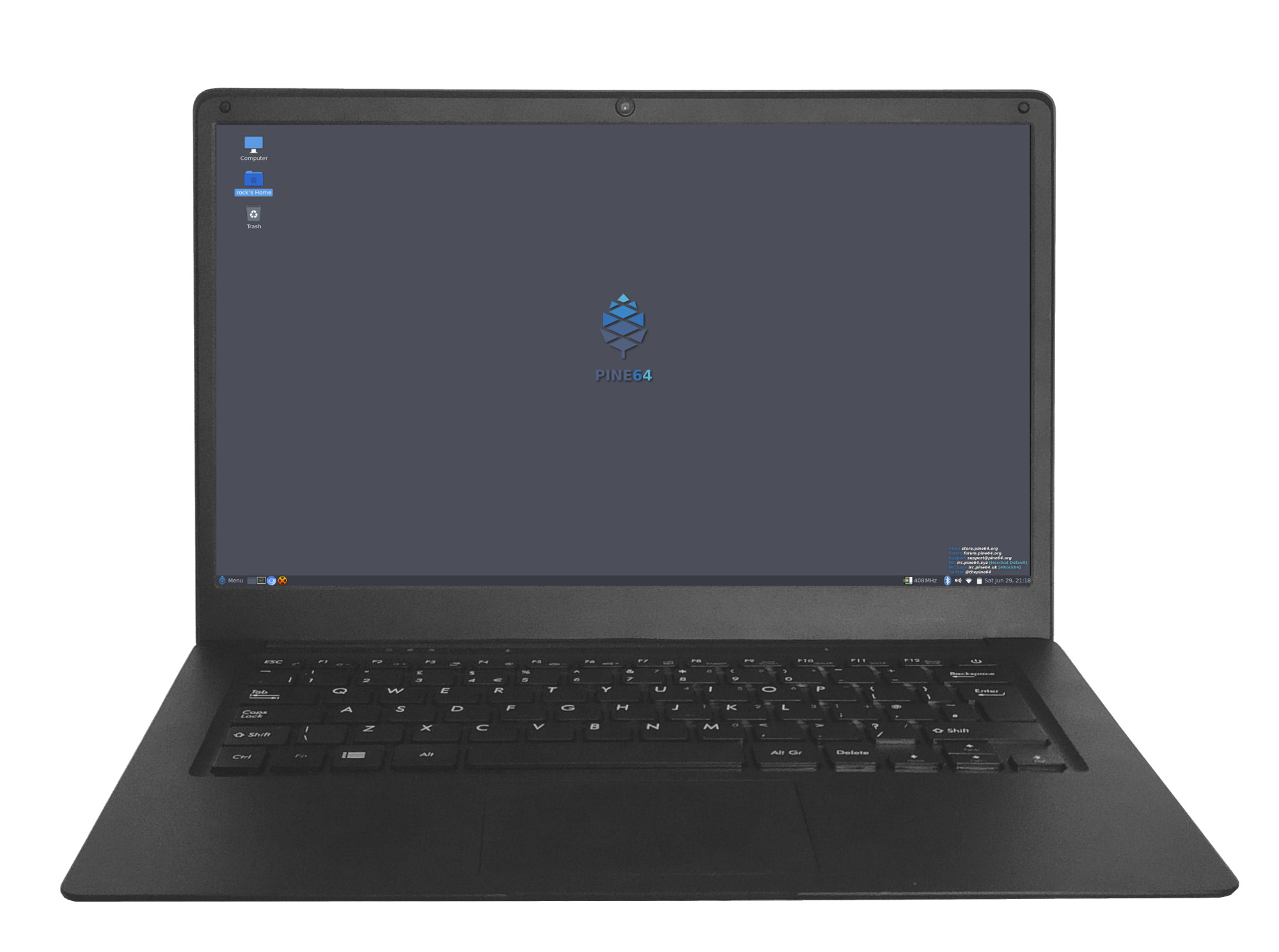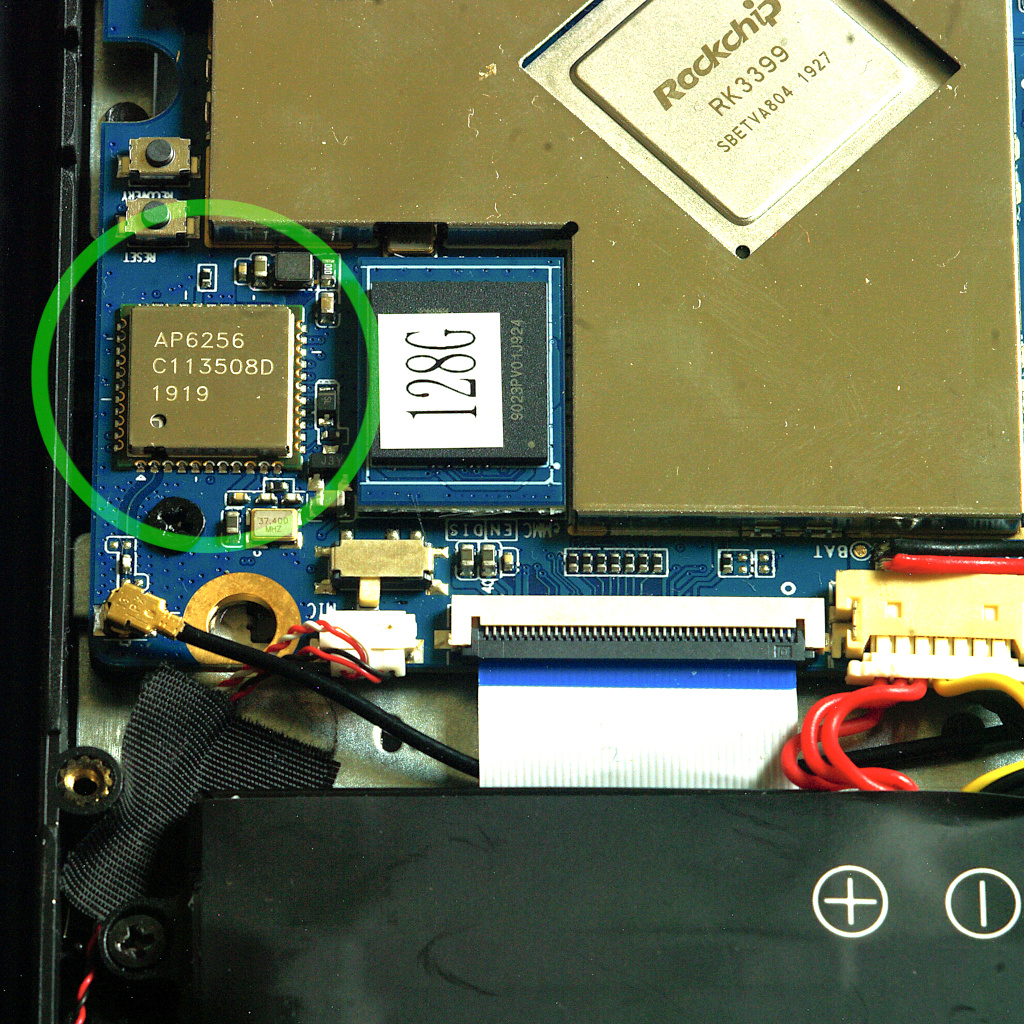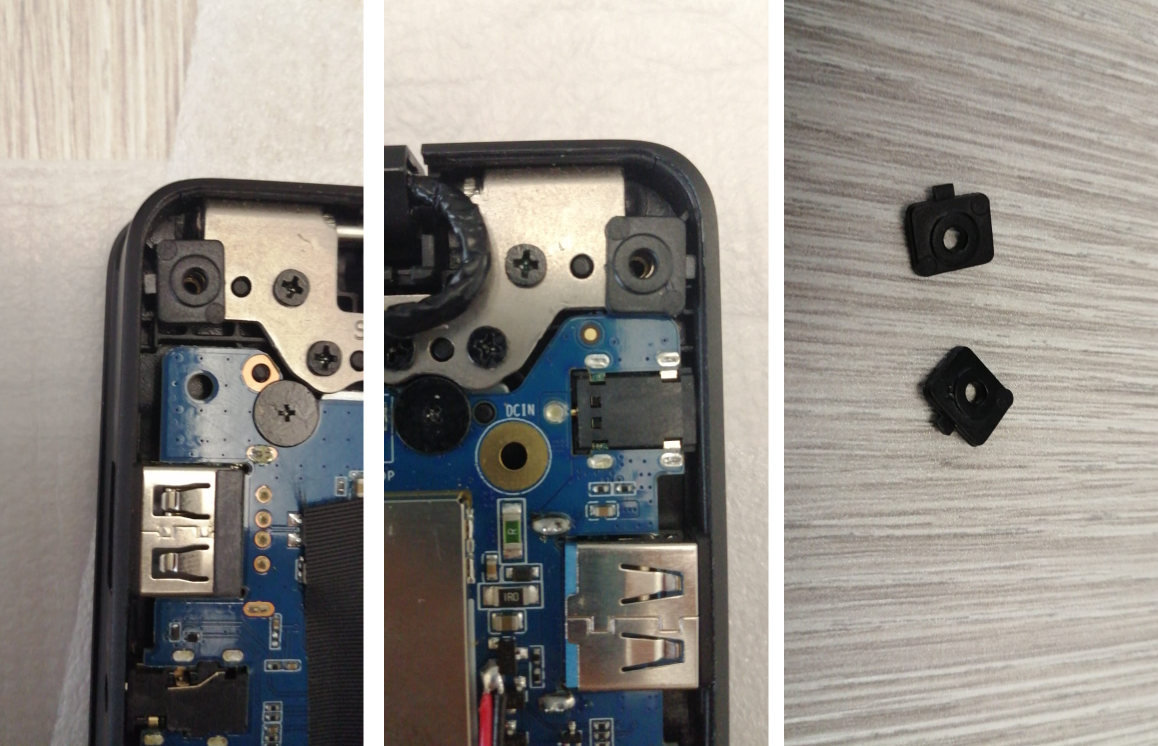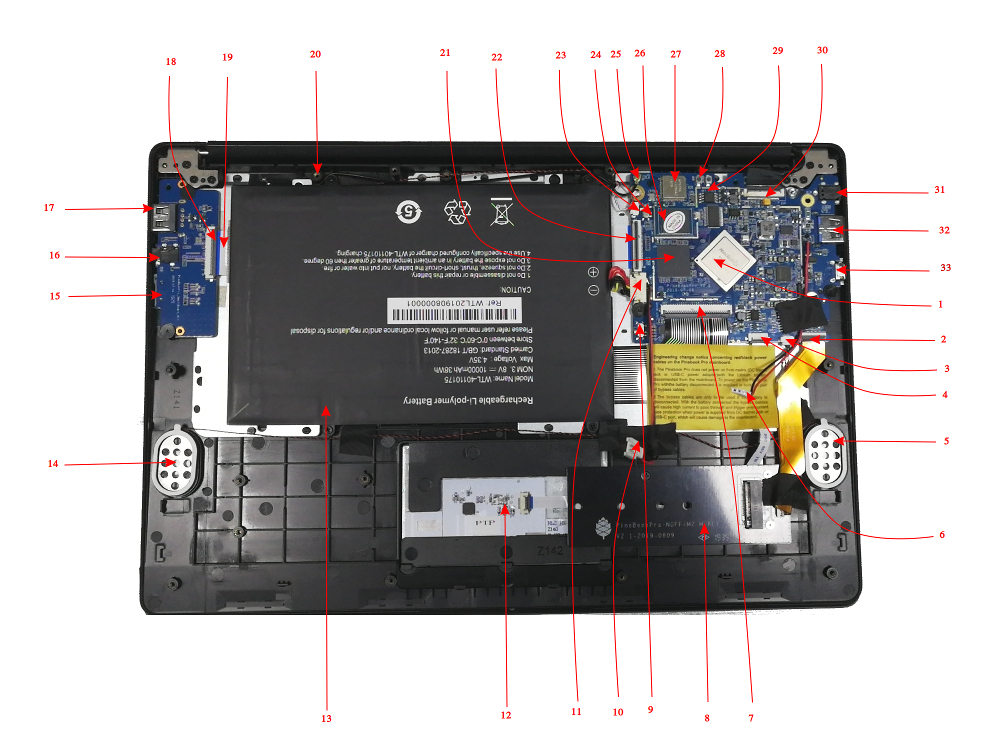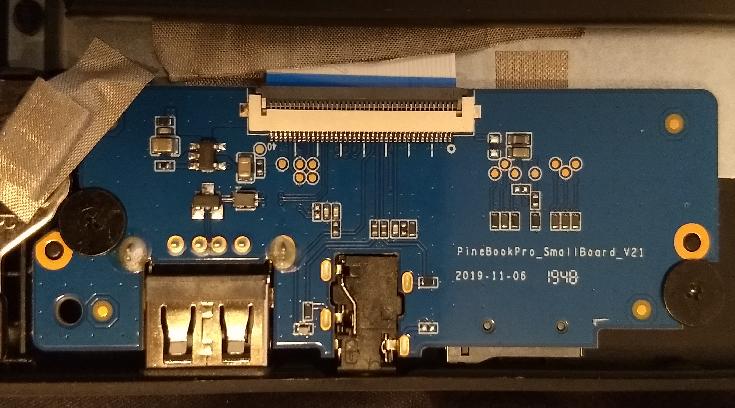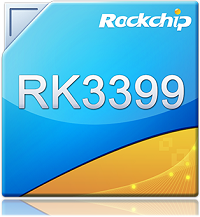Pinebook Pro
User Guide
Introducing PineBook Pro
The Pinebook Pro is a Linux and *BSD ARM laptop from PINE64
It is built to be a compelling alternative to mid-ranged Chromebooks that people convert into Linux laptops. It features an IPS 1080p 14″ LCD panel, a premium magnesium alloy shell, high capacity eMMC storage, a 10,000 mAh capacity battery, and the modularity that only an open source project can deliver.
Key features include: the RK3399 SOC; USB-C for data, video-out and power-in (3A 5V); privacy switches for the microphone, BT/WiFi module, and camera; and expandable storage via NVMe (PCIe 4x) with an optional adapter.
The Pinebook Pro is equipped with 4GB LPDDR4 system memory, high capacity eMMC flash storage, and 128Mb SPI boot Flash. The I/O includes: 1x micro SD card reader (bootable), 1x USB 2.0, 1x USB 3.0, 1x USB type C Host with DP 1.2 and power-in, PCIe 4x for an NVMe SSD drive (requires an optional adapter), and UART (via the headphone jack by setting an internal switch).
The keyboard and trackpad both use the USB 2.0 protocol. The LCD panel uses eDP MiPi display protocol.
Many different Operating Systems (OS) are freely available from the open source community and partner projects. These include various flavors of Linux (Ubuntu, Debian, Manjaro, etc.) and *BSD.
Software and OS Image Downloads
Default Manjaro KDE Desktop Quick Start
When you first get your Pinebook Pro and boot it up for the first time, it'll come with Manjaro using the KDE desktop. The Pinebook Pro is officially supported by the Manjaro ARM project, and support can be found on the Manjaro ARM forums.
On first boot, it will ask for certain information such as your timezone location, keyboard layout, username, password, and hostname. Most of these should be self-explanatory. Note that the hostname it asks for should be thought of as the "codename" of your machine, and if you don't know what it's about, you can make something up.
After you're on the desktop, be sure to update it as soon as possible and reboot after updates are finished installing. If nothing appears when you click on the Networking icon in your system tray to connect to your Wi-Fi, ensure the Wi-Fi privacy switch is not disabled.
Pinebook Pro images
Under 'Pinebook Pro Software Release/OS Image Download Section' you will find a complete list of currently supported Operating System images that work with the Pinebook as well as other related software.
The list includes OS images and descriptions of:
File:Manjaro.png Manjaro ARM (microSD and eMMC Boot)
 Debian Desktop (microSD and eMMC Boot)
Debian Desktop (microSD and eMMC Boot)
 Bionic LXDE (microSD and eMMC Boot)
Bionic LXDE (microSD and eMMC Boot)
 Bionic Mate (microSD and eMMC Boot)
Bionic Mate (microSD and eMMC Boot)
 Fedora (microSD and eMMC Boot)
Fedora (microSD and eMMC Boot)
File:Opensuse1.png OpenSUSE (microSD and eMMC Boot)
 Armbian (microSD and eMMC Boot)
Armbian (microSD and eMMC Boot)
 NetBSD (microSD and eMMC Boot)
NetBSD (microSD and eMMC Boot)
 Chromium (microSD and eMMC Boot)
Chromium (microSD and eMMC Boot)
 Arch Linux ARM installer (microSD and USB boot)
Arch Linux ARM installer (microSD and USB boot)
File:Android 7.png Android 7.1 (microSD Boot) File:Android 7.png Android 7.1 (eMMC)
 Debian Installer for Pinebook Pro
Debian Installer for Pinebook Pro
 Gentoo Script for Pinebook Pro
Gentoo Script for Pinebook Pro
File:Kali.jpeg Kali Script for Pinebook Pro (microSD and eMMC Boot)
Quick Links to OS Images Build Sources
Some of the provided OS images are still in beta or nightly build and only fit for testing purposes. These images ought to be avoided for normal usage - use them at your own risk
- ayufan's Linux build repo (Includes Ubuntu 20.04 Focal Fossa and Debian Buster images. Click 'Assets' at the end of the releases text to view images)
- ayufan's Chromium OS build repo
- mrfixit2001's Linux debian desktop build repo
Keyboard
The Pinebook Pro is available in two keyboard configurations: ISO and ANSI. Both the keyboard and trackpad in the Pinebook Pro use the USB 2.0 protocol and show up as such in xinput. The keyboard features function (Fn) keys in the F-key row, which include display brightness controls, sound volume, trackpad lock, and other functionality. There is also a custom PINE64 logo key that functions as Menu/Super key. It has also a secondary functionality for setting the privacy switches.
The keyboard firmware binary can be flashed from userspace using the provided open source utility.
Documentation for the keyboard can be found in Datasheets for Components and Peripherals.
Typing special characters
The UK ISO Layout does not have dedicated keys for characters like the German umlauts (Ä,Ö,Ü, etc). Certain characters can still be generated by means of either key combinations or key sequences.
| Character | Key combination/sequence |
|---|---|
| Ä, Ö, Ü, ä, ö, ü | [AltGr]+'[' followed by [A], [O], [U], [a], [o] or [u] |
| µ | [AltGr]+[m] |
| Ø, ø | [AltGr]+[O], [AltGr]+[o] |
| @ | [AltGr]+[q] (as on the German layout) |
| ß | [AltGr]+[s] |
| § | [AltGr]+[S] |
| ° | [AltGr]+[)] |
Privacy Switches
There are three privacy switches mapped to the F10, F11 and F12 keys on the Pinebook Pro keyboard. They de/activate the following:
| Combination | Effect | Description | Notes |
|---|---|---|---|
| PINE64 logo key+F10 | Microphone Privacy switch | CAPs lock LED blinks. 2 blinks = enabled, 3 blinks = disabled | |
| PINE64 logo key+F11 | WiFi Privacy switch | NUM lock LED blinks. 2 blinks = WiFi enabled / killswitch disabled, 3 blinks = WiFi disabled / killswitch enabled. | Re-enabling requires reboot (or a command line hack to bind/unbind). |
| PINE64 logo key+F12 | Camera privacy switch | CAPs lock and NUM lock LEDs blink together. 2 blinks = enabled, 3 blinks = disabled |
(Press the PINE64 logo key plus F10/F11/F12) for 3 seconds)
The keyboard operates on firmware independant of the operating system. It detects if one of the F10, F11 or F12 keys is pressed in combination with the Pine key for 3 seconds. Doing so disables power to the appropriate peripheral, thereby disabling it. This has the same effect as cutting off the power to each peripheral with a physical switch. This implementation is very secure, since the firmware that determines whether a peripheral gets power is not part of the Pinebook Pro’s operating system. So the power state value for each peripheral cannot be overridden or accessed from the operating system. The power state setting for each peripheral is stored across reboots inside the keyboard's firmware flash memory.
Trackpad
The trackpad is a reasonable size, has a matte finish that that your finger can slide along easily, and two actuating buttons. It is the only component of the Pinebook Pro held in place with strong adhesive tape. It supports multi-touch functionality. Documentation for the trackpad can be found in Datasheets for Components and Peripherals. The trackpad firmware binary can be flashed from userspace using the provided open source utility (https://github.com/ayufan-rock64/pinebook-pro-keyboard-updater). A fork with more recent changes is also available (https://github.com/jackhumbert/pinebook-pro-keyboard-updater) and may want to be considered instead while feature parity is different.
Everyone with a Pinebook Pro produced in 2019 should update their keyboard and trackpad firmware.
Before you start:
Please refer to original documentation for details.
Your Pinebook Pro should be either fully charged or, preferably, running of mains. This utility will be writing chips on the keyboard and trackpad, so a loss of power during any stage of the update can result in irrecoverable damage to your trackpad or keyboard.
The scripts ought to work on all OSs available for the Pinebook Pro. Some OSs may, however, require installation of relevant dependencies. The instructions below assume a Debian desktop, newer Pinebook Pro models that come with Manjaro will require a different command to install the proper dependencies.
There are two keyboard versions of the Pinebook Pro, ISO and ANSI. You need to know which model you have prior to running the updater. FW update steps for both models are listed below.
What you will need:
- Your Pinebook Pro fully charged or running off of mains power
- Connection to WiFi
- An external USB keyboard & mouse. Or access to the Pinebebook Pro via SSH
ISO Model
From the terminal command line:
git clone https://github.com/ayufan-rock64/pinebook-pro-keyboard-updater cd pinebook-pro-keyboard-updater sudo apt-get install build-essential libusb-1.0-0-dev xxd make
Step 1
cd pinebook-pro-keyboard-updater sudo ./updater step-1 iso sudo reboot
Step 2 (after reboot)
cd pinebook-pro-keyboard-updater sudo ./updater step-2 iso sudo reboot
ANSI Model
- NOTE: Running step-1 on the ansi keyboard model will make the keyboard and trackpad inaccessible until step-2 is run, so an external keyboard must be connected to complete the update on this model!
From the terminal command line:
git clone https://github.com/ayufan-rock64/pinebook-pro-keyboard-updater cd pinebook-pro-keyboard-updater sudo apt-get install build-essential libusb-1.0-0-dev xxd make
Step 1
cd pinebook-pro-keyboard-updater sudo ./updater step-1 ansi sudo reboot
Step 2 (after reboot)
cd pinebook-pro-keyboard-updater sudo ./updater step-2 ansi sudo reboot
When done, if some of the keys produce in-correct characters, please check your OSes' language settings. For ANSI users, the default OS shipped with English UK as the default language. You can change it to English US if desired.
X-Windows & trackpad settings
Some forum members have found that an adjustment to X-Windows will allow finer motion in the trackpad. If you use the Synaptic mouse/trackpad driver use this command to make the change live;
synclient MinSpeed=0.25
You may experiment with different settings, but 0.25 was tested as helping noticably.
To make the change persist across reboots, change the file /etc/X11/xorg.conf similar to below;
Section "InputClass"
Identifier "touchpad catchall"
Driver "synaptics"
MatchIsTouchpad "on"
MatchDevicePath "/dev/input/event*"
Option "MinSpeed" "0.25"
EndSection
The line Option "MinSpeed" "0.25" is the change.
Another forum user built on the above settings a little, and have found these to be very good:
synclient MinSpeed=0.25 synclient FingerLow=30 synclient PalmDetect=1 synclient VertScrollDelta=64 synclient HorizScrollDelta=64
FingerLow has the same value as 'FingerHigh' in one config (30). It is believed to help reduce mouse movement as you lift your finger, but it's not sure if synaptic works like this.
You may find this config to be comfortable for daily use.
The right mouse click is emulated by tapping with two fingers on the trackpad. If you feel that this is not very responsive you can try this value:
synclient MaxTapTime=250
.
Power Supply
- Input Power: 5V DC @ 3A
- Mechanical: 3.5mm OD / 1.35mm ID, Barrel jack
- USB-C 5V, 15W PD quickcharge
- Only use one power input at a time, barrel jack OR USB-C
LEDs
In total there are four LEDs on the Pinebook Pro, three of which are placed in the top left side of the keyboard, and one near the barrel-port:
- 1. The red LED next to the barrel-port indicates charging. It will illuminate when mains power is supplied to the Pinebook Pro from either the standard power supply unit or a USB-C smartphone charger.
- 2. The power indicator LED on the Pinebook Pro supports three different colours: green, amber and red. It is also capable of flashing/blinking to indicate activity. In the default Debian with MATE build, green LED means power and red means suspend (amber is unused).
- 3. The Num lock, green LED.
- 4. The Caps lock, green LED.
(The Num and Caps lock LEDs have a secondary function. When the privacy switches get activated they blink to confirm that switch has been activated.)
Webcam
- Streaming video resolutions supported, (un-compressed):
- 320 x 240
- 640 x 480
- 800 x 600
- 1280 x 720
- 1600 x 1200
- Still frame resolutions supported:
- 160 x 120
- 176 x 144
- 320 x 240
- 352 x 288
- 640 x 480
- 800 x 600
- 1280 x 720
- 1600 x 1200
- Some people test with the application Cheese
WIP
Microphones
While it has been said that some Pinebook Pro units contain only one microphone despite having two labeled microphone holes on the outer casing, other units do indeed contain two microphones. It is presently unclear which batches have either configuration; units from the initial community batch of 1000 units (following the initial 100) are believed to contain two, populating both labeled holes.
The wires leading to both microphones connect to the mainboard with a small white plastic connector, located directly adjacent to the ribbon cable attachment point for the keyboard interface.
Microphones not working?
If pavucontrol input doesn't show microphone activity try the Pinebook_Pro#Privacy_Switches; once that is set to on do the below; if that still hasn't fixed it you may want to check that the microphone connector is plugged in (see the Pinebook_Pro#Technical_Reference).
run alsamixer from the command line > hit F6 and select the es8316 > hit F4 to get to the capture screen > select the bar labeled ADC > > increase the gain to 0dB > change the audio profile in pavucontrol to another with input Additionally: you may want to modify ADC PGA to get the levels to where you want them
Bluetooth and WiFi
Hardware Overview
The Pinebook Pro contains an AMPAK AP6256 wireless module to provide Wi-Fi (compliant to IEEE 802.11ac) and Bluetooth (compliant to Bluetooth SIG revision 5.0). The module contains a Broadcom transceiver IC, believed to be the BCM43456, as well as the support electronics needed to allow the Wi-Fi and Bluetooth modes to share a single antenna.
The wireless module interfaces with the Pinebook Pro’s system-on-chip using a combination of three interfaces: Bluetooth functionality is operated by serial UART and PCM, while the Wi-Fi component uses SDIO. It is unknown if the module’s Bluetooth capabilites are usable under operating systems that do not support SDIO.
The module’s RF antenna pin is exposed on the mainboard via a standard Hirose U.FL connector, where a coaxial feedline links it to a flexible adhesive antenna situated near the upper right corner of the Pinebook Pro’s battery. As the RF connector is fragile and easily damaged, it should be handled carefully during connection and disconnection, and should not be reconnected frequently.
Issues
Problems have been reported with the Wi-Fi transceiver’s reliability during extended periods of high throughput, especially on the 2.4 GHz band. While the cause of this has yet to be determined, switching to the 5 GHz band may improve stability.
Since the Bluetooth transceiver shares both its spectrum and antenna with 2.4 GHz Wi-Fi, simultaneous use of these modes may cause interference, especially when listening to audio over Bluetooth. If Bluetooth audio cuts out frequently, switching to the 5 GHz band – or deactivating Wi-Fi – may help.
Wi-Fi Capabilities
Wi-Fi on the Pinebook Pro is capable of reaching a maximum data transfer rate of approximately 433 megabits per second, using one spatial stream. The transceiver does not support multiple spatial streams or 160-MHz channel bandwidths.
The Wi-Fi transceiver supports the lower thirteen standard channels on the 2.4 GHz band, using a bandwidth of 20 MHz. At least twenty-four channels are supported on the 5 GHz band, spanning frequencies from 5180 to 5320 MHz, 5500 to 5720 MHz, and 5745 to 5825 MHz, with bandwidths of 20, 40, or 80 MHz.
Maximum reception sensitivity for both bands is approximately -92 dBm. The receiver can tolerate input intensities of no more than -20 dBm on the 2.4 GHz band, and no more than -30 dBm on the 5 GHz band. Maximum transmission power is approximately +15 dBm for either band, falling further to approximately +10 dBm at higher data transfer rates on the 5 GHz band.
With current available drivers and firmware, the Wi-Fi interface supports infrastructure, ad-hoc, and access-point modes with satisfactory reliability. Monitor mode is not presently supported. Wi-Fi Direct features may be available, but it is unclear how to make use of them under Linux.
Be aware that Linux userspace utilities, such as iw, may report inaccurate information about the capabilities of wireless devices. Parameter values derived from vendor datasheets, or direct testing, should be preferred to the outputs of hardware-querying tools.
Bluetooth Capabilities
Bluetooth data transfer speeds have an indicated maximum of 3 megabits per second, but it is unclear what practical data rates can be expected. Audio streaming over Bluetooth is functioning normally, as is networking. Bluetooth Low-Energy functions, such as interacting with Bluetooth beacons, have not yet been tested conclusively.
The Bluetooth transceiver supports all 79 channel allocations, spanning frequencies from 2402 MHz to 2480 MHz. Reception sensitivity is approximately -85 dBm, with a maximum tolerable reception intensity of -20 dBm. Bluetooth transmission power is limited to +10 dBm.
Disabling Bluetooth
#disable bluetooth once sudo rfkill block bluetooth && #confirm rfkill
#disable bluetooth on boot** sudo systemctl enable rfkill-block@bluetooth
**This does not do what one might want on certain distros, Manjaro XFCE for example. Try the below.
right click on the bluetooth panel icon > select 'plugins' > PowerManager > configuration > deselect the auto power on option
LCD Panel
- Model: BOE NV140FHM-N49
- 14.0" (35.56cm) diagonal size
- 1920x1080 resolution
- 60hz refresh rate
- IPS
- 1000:1 contrast
- 250nt brightness
- 63% sRGB coverage
- 6 bit colour
- 30 pin eDP connection
Some people have tested hardware video decode using the following;
ffmpeg -benchmark -c:v h264_rkmpp -i file.mp4 -f null -
External ports list
Here are a list of the external ports. See Technical Reference - Expansion Ports for port specifications.
- Left side
- Barrel jack for power, (with LED)
- USB 3, Type A
- USB 3, Type C
- Right side
- USB 2, Type A
- Standard headset jack
- MicroSD card slot
Using the UART
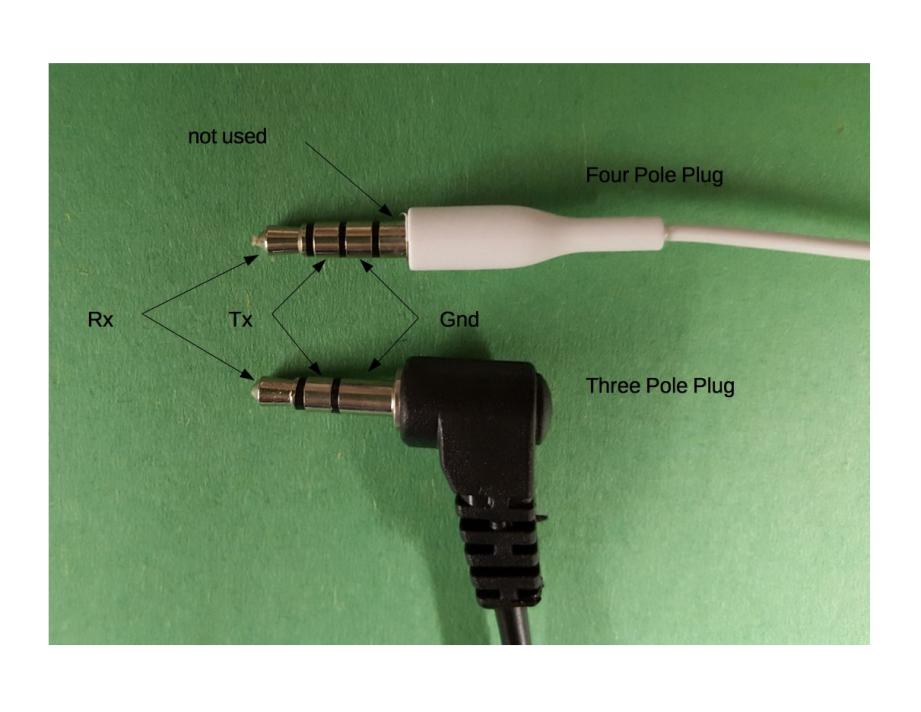
Swapping the tx and rx around from this also works and is more traditional.
See this official Pine64 .pdf.
UART output is enabled by flipping the UART switch to the ON position (item 9). To do so you need to remove the Pinebook Pro's bottom cover - please follow proper disassembly and reassembly protocol. The OFF position is towards the touchpad, the ON position is towards the display hinges.
With the UART switch in the ON position, console is relayed via the audiojack and the laptop's sound is turned OFF. Please ensure that you are using a 3.3v interface (such as the CH340, FTDI-232R, or PL2303, which are sold in both 3.3v and 5v variants) to avoid damage to the CPU.
Insert the USB plug of the cable into an open USB port on the machine which will monitor. Run the following in a terminal:
$ lsusb
you should find a line similar to this:
Bus 001 Device 058: ID 1a86:7523 QinHeng Electronics HL-340 USB-Serial adapter
You may have to clean the USB contacts of the Serial cable to get a good connection if you do not find that line.
The audio jack of the Serial cable should be fully inserted into the Pinebook Pro audio port.
Serial output should now be accessible using screen, picocom or minicom (and others). Examples:
screen /dev/ttyUSB0 1500000
picocom /dev/ttyUSB0 -b 1500000
minicom -D /dev/ttyUSB0 -b 1500000
Old versions of U-Boot do not use the UART for console output. The console function is activated by the Linux kernel. Thus, if you use a non-Pinebook Pro Linux distro and want the UART as a console, you have to manually enable it.
Using the optional NVMe adapter
The optional NVMe adapter allows the use of M.2 cards that support the NVMe standard, (but not SATA standard). The optional NVMe M.2 adapter supports M & M+B keyed devices, in both 2242 & 2280 physical sizes, the most common ones available. In addition, 2230 & 2260 are also supported, though NVMe devices that use those sizes are rare.
Once you have fitted and tested your NVMe drive, please add a note to this page Pinebook_Pro_Hardware_Accessory_Compatibility to help build a list of tried and tested devices.
Installing the adapter
The V2.1-2019-0809 SSD adapter that shipped with the initial Pinebook Pro batches had significant issues. A repair kit will be shipped to address those issues. (If necessary, it can be modified to work. There is an unofficial tutorial on the forums describing these modifications.)
The updated SSD adapter, labeled V2-2019-1107, takes into account the prior problems with trackpad interference. New orders as of Feb. 22nd, 2020 will be the updated adapter.
Actual installation instructions are a work in progress. Unofficial instructions for installing V2-2019-1107 can be found here.
Post NVMe install power limiting
Some NVMe SSDs allow reducing the maximum amount of power. Doing so may reduce the speed, but it may be needed in the Pinebook Pro to both improve reliability at lower battery levels. And to reduce power used, to maintain battery life. Here are the commands to obtain and change the power settings. The package 'nvme-cli' is required to run these commands. The example shows how to find the available power states, and then sets it to the lowest, non-standby setting, (which is 3.8 watts for the device shown);
$ sudo nvme id-ctrl /dev/nvme0
NVME Identify Controller:
...
ps 0 : mp:9.00W operational enlat:0 exlat:0 rrt:0 rrl:0
rwt:0 rwl:0 idle_power:- active_power:-
ps 1 : mp:4.60W operational enlat:0 exlat:0 rrt:1 rrl:1
rwt:1 rwl:1 idle_power:- active_power:-
ps 2 : mp:3.80W operational enlat:0 exlat:0 rrt:2 rrl:2
rwt:2 rwl:2 idle_power:- active_power:-
ps 3 : mp:0.0450W non-operational enlat:2000 exlat:2000 rrt:3 rrl:3
rwt:3 rwl:3 idle_power:- active_power:-
ps 4 : mp:0.0040W non-operational enlat:6000 exlat:8000 rrt:4 rrl:4
rwt:4 rwl:4 idle_power:- active_power:-
$ sudo nvme get-feature /dev/nvme0 -f 2
get-feature:0x2 (Power Management), Current value:00000000
$ sudo nvme set-feature /dev/nvme0 -f 2 -v 2 -s
set-feature:02 (Power Management), value:0x000002
Some NVMe SSDs don't appear to allow saving the setting with "-s" option. In those cases, leave off the "-s" and use a startup script to set the non-default power state at boot.
If you want to test performance without saving the new power setting semi-permanantly, then leave off the "-s" option.
There is another power saving feature for NVMes, APST, (Autonomous Power State Transitions). This performs the power saving & transitions based on usage. To check if you have a NVMe SSD with this feature;
$ sudo nvme get-feature -f 0x0c -H /dev/nvme0
Information for this feature, (on a Pinebook Pro), is a work in progress.
Using as data drive
As long as the kernel in use has both the PCIe and NVMe drivers, you should be able to use a NVMe drive as a data drive. It can automatically mount when booting from either the eMMC or an SD card. This applies to Linux, FreeBSD, and Chromium, using the normal partitioning and file system creation tools. Android requires testing.
Using as OS root drive
The SoC does not include the NVMe boot code, so the NVMe is not in the SoC's boot order. However, using the U-Boot update script from the mrfixit2001 Debian or Arglebargle's modified script, and the modified u-boot images provided by forum user pcm720, you can now add support to boot from an NVMe drive. Binary images are useable with SD, eMMC, and SPI flash. For OS images using the mainline kernel, there are a few variants of U-Boot available that also support NVMe as the OS drive. Though these may require writing the U-Boot to the SPI flash for proper use of the NVMe as the OS drive.
The current boot order, per last testing, for this modified U-Boot is:
- MicroSD
- eMMC
- NVMe
For more information, please refer to the forum post.
It is also possible to initially boot off an eMMC or SD card, then transfer to a root file system on the NVMe. Currently, it is necessary to have the U-Boot code on an eMMC or SD card. (A forum member posted here about using a modified version of U-Boot with NVMe drivers, that uses /boot and / off the NVMe drive. So this may change in the future.)
Please see Bootable Storage.
Caring for the PineBook Pro
Bypass Cables
The mainboard features two (disconnected by default) bypass cables that are only to be used with the battery disconnected. The female (10) male (6) ends of the bypass cables can be connected to provide power to the mainboard if you need to run the laptop without a battery. Please refer to this engineering notice.
Note that despite the bypass cable being a two conductor cable, it is only used as one. Both wires being soldered together on either side is normal!
WARNING: Do not connect the bypass cables with the battery connected. Using the bypass cables with the battery connected can permanently damage the computer.
Pinebook Service Step-by-Step Guides
Placeholder for Pinebook Pro specific guides
Under 'Service Guides for Pinebook' you can find instructions guides concerning disassembly of:
Note: The installation process on Pinebook Pro similar to 14" Pinebook
Note: The installation process is the reverse order of removal guide
- 14″ Pinebook Lithium Battery Pack Removal Guide
- 14″ Pinebook LCD Panel Screen Removal Guide
- 14″ Pinebook eMMC Module Removal Guide
Using the SPI flash device
The Pinebook Pro comes with a 128Mbit, (16MByte), flash device suitable for initial boot target, to store the bootloader. The SoC used on the Pinebook Pro boots from this SPI flash device first, before eMMC or SD card. At present, April 19, 2020, the Pinebook Pros ship without anything programmed in the SPI flash device. So the SoC moves on to the next potential boot device, the eMMC. ARM/ARM64 computers do not have a standardized BIOS, yet.
Here is some information on using the SPI flash device:
- You need the kernel built with SPI flash device support, which will supply a device similar to:
/dev/mtd0 - The Linux package below, will need to be available:
mtd-utils - You can then use this program from the package to write the SPI device:
flashcp <filename> /dev/mtd0
Even if you need to recover from a defective bootloader written to the SPI flash, you can simply short pin 6 of the SPI flash to GND and boot. This will render the SoC bootrom unable to read from the SPI flash and have it fall back to reading the bootloader from other boot media like the eMMC or Micro SD card.
The procedures described above are a lot less risky than attaching an external SPI flasher and do not require any additional hardware.
At present, April 19th, 2020, there is no good bootloader image to flash into the SPI flash device. This is expected to change, as there are people working on issue.
FAQ
What cool software works out of the box? Pinebook Pro OTB Experience
Software tuning guide
Details on how to get the most out of a Pinebook Pro & its RK3399 SoC.
Customizing the Pinebook Pro's default Manjaro KDE system
Watching DRM content (Netflix, etc.)
Most paid online streaming services use Widevine DRM to make their content more difficult to pirate. Widevine is not directly supported on Manjaro KDE, however it is still possible to watch DRM content via the "chromium-docker" package which downloads a 32-bit ARM container and installs Chromium with Widevine inside of that. While not space-efficient, or efficient in general, it's the recommended solution for watching this content on your Pinebook Pro. You can install this package with:
sudo pacman -Sy chromium-docker
Checking GPU capabilities
To see what versions of OpenGL and OpenGL ES are supported by the Pinebook Pro, what driver is in use, and what version of the driver is loaded, install the "mesa-demos" package with:
sudo pacman -Sy mesa-demos
And then run:
glxinfo | grep OpenGL
This will give detailed information about your graphics card and driver, useful for debugging.
Better GPU compatibility and performance
For better graphics performance, you may install the "mesa-git" package, built and supplied in the Manjaro ARM repos. This lets you bring in the latest features, optimizations, and bugfixes for the graphics driver used by the Pinebook Pro. Installation is as simple as:
pacman -Sy mesa-git
Then you may reboot to load the newer driver.
Note that this might also solve graphical glitches that you were seeing previously.
OpenGL ES 3.0 support
By default, with the current state of the Panfrost GPU driver, the Pinebook Pro supports OpenGL 2.1 and OpenGL ES 2.0. If you want to use OpenGL ES 3.0, you need to set the system-wide environment variable, open the /etc/environment file with:
kate /etc/environment
And then at the bottom of the file, on a new line, add:
PAN_MESA_DEBUG="gles3"
Then save the file, entering your password when prompted, and reboot the system. When you check your GPU capabilities, it should report OpenGL ES 3.0 and applications that rely on it should function properly. Note that GLES3 support is currently incomplete and some advanced rendering features may still not work properly.
Customizing the Pinebook Pro's previously-default Debian system
Here are some hints on what you can do to customize the Pinebook Pro's previous factory image (aka mrfixit2001 debian build)
Initial user changes, password, name, etc
When you first get your Pinebook Pro, you should consider setting strong passwords and making the default account your own.
- Reboot (this is just to ensure all background processes belong to the user are not running... there are other ways to achieve this but this way is easy)
- Once the machine reboots press Alt-Ctrl-F1 to bring up a text terminal
- Login as root (login: root, password: root)
- Set a strong password for the root user using the following command and it's prompts:
# passwd (and follow prompts)
- Rename the rock user to your prefered username (replace myself with whatever you like):
# usermod -l myself -d /home/myself -m rock
- Rename the rock group to match your preferred username:
# groupmod -n myself rock
- Put your name in the account, (replace "John A Doe" with your name):
# chfn -f "John A Doe" myself
- Set a strong password for the normal user:
# passwd myself
- Log out of the text terminal:
# logout
- Press Alt-Ctrl-F7 to go back to the login screen and then login as the normal user
- Open text terminal to fix login error: "Configured directory for incoming files does not exist";
$ blueman-services
Select "Transfer" tab and set "Incoming Folder" to myself OR If adduser is in distro, this is MUCH easier sudo adduser $USER ,, fill out requested data Then,, sudo adduser $USER $GROUP,,, 1 group at a time To see which groups to add,,, id $USER, id rock
Changing the default hostname
Debian 9 has a command to allow you to change the hostname. You can see the current settings using;
> sudo hostnamectl
Static hostname: Debian-Desktop
Icon name: computer
Machine ID: dccbddccbdccbdccbdccbdccbdccbccb
Boot ID: ea99ea99ea99ea99ea99ea99ea99ea99
Operating System: Debian GNU/Linux 9 (stretch)
Kernel: Linux 4.4.210
Architecture: arm64
To change, use this, (with "My_Hostname" used as the example);
> sudo hostnamectl set-hostname My_Hostname
Whence done, you can re-verify using the first example.
Then you should backup and edit your /etc/hosts entry's name;
> sudo cp -p /etc/hosts /etc/hosts.`date +%Y%m%d` > sudo vi /etc/hosts 127.0.0.1 localhost 127.0.0.1 My_Hostname ::1 localhost ip6-localhost ip6-loopback fe00::0 ip6-localnet ff00::0 ip6-mcastprefix ff02::1 ip6-allnodes ff02::2 ip6-allrouters 127.0.1.1 linaro-alip
Disable Chromium browser's prompt for passphrase & password storage
Perform the following steps:
- On the tool bar, hover over the Chromium icon
- Using the right mouse button, select Properties
- In the Command: line section, add
--password-store=basicbefore the%U - Use the x Close button to save the change
This will of course, use basic password storage, meaning any saved passwords are not encrypted. Perfectly fine if you never use password storage.
Changing the boot splash picture
The default boot splash picture can be replaced using the following instructions:
- Install ImageMagick which will do the conversion
$ sudo apt-get install imagemagick
- Create a 1920 x 1080 picture. For the best results, use a PNG image (It supports lossless compression).
- From the directory in which your new image is stored run the following commands
- Convert your image to the bootsplash raw format using imagemagick convert.
$ convert yoursplashimage.png -separate +channel -swap 0,2 -combine -colorspace sRGB RGBO:splash.fb
- Create a backup copy of your current splash screen
$ sudo cp /usr/share/backgrounds/splash.fb /usr/share/backgrounds/splash_original.fb
- Copy your new splash screen into place
$ sudo cp splash.fb /usr/share/backgrounds/splash.fb
- Set the correct permissions on the splash.fb file
$ sudo chmod 644 /usr/share/backgrounds/splash.fb
- If you do not want to see kernel console text messages, make sure you don't have Plymouth installed
Watching Amazon Prime videos with Chromium
When you create a new user, it will be necessary to launch the Chromium browswer with a specific user agent like below;
chromium-browser --user-agent="Mozilla/5.0 (X11; CrOS armv7l 6946.63.0) AppleWebKit/537.36 (KHTML, like Gecko) Chrome/72.0.3626.121 Safari/537.36"
There may be more tweaks needed.
Enabling text boot time messages
By default, most Linux distros have a boot screen with a picture. To see all the boot time messages, use one of the following;
Default Debian
- Backup and edit the U-Boot configuration file:
cp -p /etc/default/u-boot /etc/default/u-boot.`date +%Y%m%d` chmod a-w /etc/default/u-boot.`date +%Y%m%d` vi /etc/default/u-boot
Remove the quiet and splash parameters. Leave everything else alone.
- Update the U-Boot configuration:
u-boot-update
- Test and verify you get what you think you should be seeing.
Manjaro
- Backup and edit the U-Boot configuration file:
cp -p /boot/extlinux/extlinux.conf /boot/extlinux/extlinux.conf.`date +%Y%m%d` chmod a-w /boot/extlinux/extlinux.conf.`date +%Y%m%d` vi /boot/extlinux/extlinux.conf
Change console=ttyS2,150000 to console=tty1
Remove the bootsplash.bootfile option and it's parameter.
You can add verbose logging by appending ignore_loglevel to the line where boot splash was.
Leave everything else alone.
- Test and verify you get what you think you should be seeing.
Improving readability
Some people find that a 14" LCD screen with 1080p, (1920 x 1080), has text and icons a bit too small. There are things you can do to make the screen easier to use & read.
- Increase the font size
- Use a font with more pronounce features
- Increase the various window manager sizes, (like increase the height of the tool bar)
- Change the color scheme to be easier on the eyes, (even though it may not be bigger, proper contrast can help usability)
- Change the window manager's decorations, (like using larger icons)
- Use a workspace manager, (so one application per workspace)
- When at home or office, use an external monitor
- Changing the X-Window's DPI, (Dot's Per Inch), can help too
However, do not change the resolution of the LCD screen, otherwise you may end up with a blank / black screen. If that happens, see this trouble shooting section for the fix:
Blank screen after changing builtin LCD resolution
Chromium tweaks
Flags
From the official Debian image:
--disable-low-res-tiling \ --num-raster-threads=6 \ --profiler-timing=0 \ --disable-composited-antialiasing \ --test-type \ --show-component-extension-options \ --ignore-gpu-blacklist \ --use-gl=egl \ --ppapi-flash-path=/usr/lib/chromium-browser/pepper/libpepflashplayer.so \ --ppapi-flash-version=32.0.0.255 \ --enable-pinch \ --flag-switches-begin \ --enable-gpu-rasterization \ --enable-oop-rasterization \ --flag-switches-end
Note that in some cases, this may also decrease performance substantially, as observed when using these flags on the Manjaro KDE desktop. Feel free to experiment to find what is smoothest for you personally.
GVIM has performance issue
It appears that using GTK3 can cause very slow scolling, while VIM in a terminal window works fine.
Simply revert back to using GTK2, (how to do so, is somewhat Linux distro specific).
Kernel options
Here are some Pinebook Pro & its RK3399 SoC Linux specific options. If kernel version, (or version range specific), it should list that information in the description.
To see if a specific feature is enabled in the current kernel, you can use something like this;
$ zgrep -i rockchip_pcie /proc/config.gz # CONFIG_ROCKCHIP_PCIE_DMA_OBJ is not set CONFIG_PHY_ROCKCHIP_PCIE=m
If it's listed as =m, then it's a module. You can see if the module is loaded with;
$ lsmod | grep -i rockchip_pcie phy_rockchip_pcie 16384 0
Note modules are not loaded until needed. Thus, we sometimes check the kernel configuration instead to see if a feature is configured first, then see if it's a module.
Hardware video decoding
Here is a method to check for hardware video decoding by the VPU. There are special Linux kernel modules that perform this function.
Older systems, such as the previously-default Debian desktop, use the Rockchip-supplied kernel module rk-vcodec. To check, something like this can be used:
$ lsmod | grep rk-vcodec
or
$ zgrep RK_VCODEC /proc/config.gz
CONFIG_RK_VCODEC=y
Note that in the above example, the Rockchip video CODEC is not built as a module, but included into the kernel. Thus, it does not show up in the list modules check.
Newer systems may use a different option as in the configuration below:
$ zgrep HANTRO /proc/config.gz CONFIG_VIDEO_HANTRO=m CONFIG_VIDEO_HANTRO_ROCKCHIP=y
Troubleshooting guide
The important thing is not to panic and if something goes wrong, to stop and consider carefully how to undo something, or, to redo it. This particularly applies when flashing a new operating system or new firmware to the touchpad.
Pinebook_Pro_Troubleshooting_Guide
PineBookPro Hardware Compatibility
Please contribute to the hardware compatibility page, which lists hardware which has been tested with the PBP, whether successful or not!
Technical Reference
Accessing the Internals - Disassembly and Reassembly
WARNING: Do not open the laptop by lifting the lid while the Pinebook Pro bottom cover is removed - this can cause structural damage to the hinges and/or other plastic components of the chassis such as the IO port cut-outs.
WARNING: When removing the back cover plate, use care if sliding fingertips between back cover plate and palm rest assembly. The back cover plate edges are sharp.
WARNING: When removing the back cover plate, use care to avoid damaging the speakers. They are stuck to the back cover with double-sided tape, and the thin wires are very delicate.
When disassembling the laptop make sure that it is powered off and folded closed. To remove the bottom cover of the Pinebook Pro, first remove the ten (10) Phillips head screws that hold the bottom section of the laptop in place. Remove the cover from the back where the hinges are situated by lifting it up and away from the rest of the chassis.
During reassembly, make sure that the back-screw standoffs are in place and seated correctly. To reassemble the Pinebook Pro, slide the bottom section into place so it meets the front lip of the keyboard section. Secure the front section (where the trackpad is located) in place using the short screws in the front left and right corners. Then proceed to pop in the bottom panel into place. Secure the bottom section (where hinges are located) by screwing in the left and right corners. Then screw in the remaining screws and run your finger though the rim on the chassis to make sure its fitted correctly. Note that the front uses the remaining 2 short screws.
NOTE: The screws are small and should only be finger tight. Too much force will strip the threads. If after installing screws the back cover plate has not seated properly on one side, open the display and hold the base on either side of the keyboard and gently flex the base with both hands in opposing directions. Once the side pops further in, then recheck the screws on that side. If it does not pop back in, just let it be.
NOTE: a basic 3d model to print replacement back-screw standoffs is available on Thingiverse [1] pending release of something more definitive
Pinebook Pro Internal Layout
Main chips
- RK3399 system-on-chip (1)
- LPDDR4 SDRAM (21)
- SPI NOR flash memory (29)
- eMMC flash memory (26)
- WiFi/BT module (27)
Mainboard Switches and Buttons
There are two switches on the main board: disabling the eMMC (24), and enabling UART (9) via headphone jack.
The Reset and Recovery buttons (28): the reset button performs an immediate reset of the laptop. The Recovery button is used to place the device in maskrom mode; this mode allows flashing eMMC using Rockchip tools (e.g. rkflashtools).
Key Internal Parts
| Number | Type | Descriptor |
|---|---|---|
| 1 | Component | RK3399 System-On-Chip |
| 2 | Socket | PCIe 4X socket for optional NVMe adapter |
| 3 | Socket | Speakers socket |
| 4 | Socket | Trackpad socket |
| 5 | Component | Left speaker |
| 6 | Connector | Male power bridge connector |
| 7 | Socket | Keyboard Socket |
| 8 | Component | Optional NVMe SSD adapter |
| 9 | Switch | UART/Audio switch - outputs UART via headphone jack |
| 10 | Socket | Female power bridge socket |
| 11 | Socket | Battery socket |
| 12 | Component | Trackpad |
| 13 | Component | Battery |
| 14 | Component | Right speaker |
| 15 | Socket | MicroSD card slot |
| 16 | Socket | Headphone / UART jack |
| 17 | Socket | USB 2.0 Type A |
| 18 | Socket | Daughterboard-to-mainboard ribbon cable socket |
| 19 | Cable | Daughterboard-to-mainboard ribbon cable |
| 20 | Component | microphone |
| 21 | Component | LPDDR4 RAM |
| 22 | Socket | Mainboard-to-daughterboard ribbon cable socket |
| 23 | Socket | Microphone socket |
| 24 | Switch | Switch to hardware disable eMMC |
| 25 | Antenna | BT/WiFI antenna |
| 26 | Component | eMMC flash memory module |
| 27 | Component | BT/WiFi module chip |
| 28 | Buttons | Reset and recovery buttons |
| 29 | Component | SPI flash storage |
| 30 | Socket | eDP LCD socket |
| 31 | Socket | Power in barrel socket |
| 32 | Socket | USB 3.0 Type A |
| 33 | Socket | USB 3.0 Type C |
Smallboard detailed picture
Bootable Storage
The Pinebook Pro is capable of booting from eMMC, USB 2.0, USB 3.0, or an SD card. It cannot boot from USB-C. The boot order of the hard-coded ROM of its RK3399 SoC is: SPI NOR, eMMC, SD, USB OTG.
At this time, the Pinebook Pro ships with a Manjaro + KDE build with uboot on the eMMC. Its boot order is: SD, USB, then eMMC.
(An update has been pushed for the older Debian + MATE build that improves compatibility with booting other OSs from an SD card. In order to update, fully charge the battery, establish an internet connection, click the update icon in the toolbar, and then reboot your Pinebook Pro. Please see this log for details.)
Please note that PCIe, the interface used for NVMe SSD on the Pinebook Pro, is not bootable on the RK3399 and therefore is not a part of the boot hierarchy. It is possible to run the desired OS from NVMe by pointing extlinux on the eMMC to rootfs on the SSD. This requires uboot, the Kernel image, DTB, and extlinux.conf in a /boot partition on the eMMC.
eMMC information
The eMMC appears to be hot-pluggable. This can be useful if trying to recover data or a broken install. Best practice is probably to turn the eMMC switch to off position before changing modules.
The eMMC storage will show up as multiple block devices:
- mmcblk1boot0 - eMMC standard boot0 partition, may be 4MB
- mmcblk1boot1 - eMMC standard boot1 partition, may be 4MB
- mmcblk1rpmb - eMMC standard secure data partition, may be 16MB
- mmcblk1 - This block contains the user areas
Only the last is usable as regular storage device in the Pinebook Pro. The device number of "1" shown above may vary, depending on kernel.
If the eMMC module is enabled after boot from an SD card, you can detect this change with the following commands as user "root";
echo fe330000.sdhci >/sys/bus/platform/drivers/sdhci-arasan/unbind echo fe330000.sdhci >/sys/bus/platform/drivers/sdhci-arasan/bind
Boot sequence details
The RK3399's mask 32KB ROM boot code looks for the next stage of code at byte off-set 32768, (sector 64 if using 512 byte sectors). This is where U-Boot code would reside on any media that is bootable.
RK3399 boot sequence
Pinebook Pro Dimensions
- Dimensions: 329mm x 220mm x 12mm (WxDxH)
- Weight: 1.26Kg
- Screws
- Philips head type screws
- M2 flat head machine screws (measurements in mm)
- 4 x Small screws (used along the front edge): Head - 3.44, Thread Diameter - 1.97, Thread Length - 2.1, Overall length - 3.05
- 6 x Large screws: Head - 3.44, Thread Diameter - 1.97, Thread Length - 4.41, Overall Length - 5.85
- Rubber Feet
- 18mm diameter
- 3mm height
- Dome shaped
SoC and Memory Specification
- Based on Rockchip RK3399
CPU Architecture
- big.LITTLE architecture: Dual Cortex-A72 + Quad Cortex-A53, 64-bit CPU
- Full implementation of the ARM architecture v8-A instruction set (both AArch64 and AArch32)
- ARM Neon Advanced SIMD (single instruction, multiple data) support for accelerated media and signal processing computation
- ARMv8 Cryptography Extensions
- VFPv4 floating point unit supporting single and double-precision operations
- Hardware virtualization support
- TrustZone technology support
- Full CoreSight debug solution
- One isolated voltage domain to support DVFS
- Cortex-A72 (big cluster):
- Dual-core Cortex-A72 up to 2.0GHz CPU
- Superscalar, variable-length, out-of-order pipeline
- L1 cache 48KB Icache and 32KB Dcache for each A72
- L2 cache 1024KB for big cluster
- Cortex-A53 (little cluster):
- Quad-core Cortex-A53 up to 1.5GHz CPU
- In-order pipeline with symmetric dual-issue of most instructions
- L1 cache 32KB Icache and 32KB Dcache for each A53
- L2 cache 512KB for little cluster
- Cortex-M0 (control processors):
- Cortex-M0 CPU
- Two Cortex-M0 cooperate with the central processors
- Architecture: Armv6-M
- Thumb/Thumb2 instruction set
- 32 bit only
GPU Architecture
- ARM Mali-T860MP4 Quad-core GPU
- The highest performance GPUs built on Arm Mali’s famous Midgard architecture, the Mali-T860 GPU is designed for complex graphics use cases and provide stunning visuals for UHD content.
- Frequency 650MHz
- Throughput 1300Mtri/s, 10.4Gpix/s
- Graphic interface standards:
- OpenGL® ES 1.1, 1.2, 2.0, 3.0, 3.1, 3.2. (Panfrost has initial support of 3.0 beginning 2020/02/27)
- Vulkan 1.0, using the Mali binary blob. (Panfrost does not support Vulkan as of 2020/06/24)
- OpenCL™ 1.1, 1.2
- DirectX® 11 FL11_1
- RenderScript™
System Memory
- RAM Memory:
- LPDDR4
- 800MHz, (limited by RK3399)
- Dual memory channels on the CPU, each 32 bits wide
- Quad memory channels on the RAM chip, each 16 bits wide, 2 bonded together for each CPU channel
- 4GB as a single 366 pin mobile RAM chip
- Storage Memory:
- 64GB eMMC module, can be upgraded to an 128GB eMMC module. (The initial PINE64 community build version shipped with a 128GB eMMC.)
- eMMC version 5.1, HS400, 8 bit on RK3399 side
- Bootable
- SPI flash:
- 128Mbit / 16MByte
- 1 bit interface
- Bootable, (first boot device, ahead of eMMC & SD card)
- U-Boot images can be made to work, but as of 2020/06/24 there is no standardized image available.
Video out
- USB-C Alt mode DP
- Up to 3840x2160 p60, dependant on adapter, (2 lanes verses 4 lanes)
Expansion Ports
- MicroSD card:
- Bootable
- Supports SD, SDHC and SDXC cards, up to 512GB tested. SDXC standard says 2TB is the maximum.
- Version SD3.0, (MMC 4.5), up to 50MB/s
- SD card Application Performance Class 1 (A1), (or better), recommended by some users, for better IOPS
- USB ports:
- 1 x USB 2.0 Type-A Host Port, bootable
- 1 x USB 3.0 Type-A Host Port, 5Gbps, is not bootable
- 1 x USB 3.0 Type-C OTG Port, 5Gbps, (includes laptop charging function), is not bootable
- Note that high power USB devices may not work reliably on a PBP. Or they may draw enough power to drain the battery even when the PBP is plugged into A.C. One alternative is externally powered USB devices.
- Headphone jack switchable to UART console mux circuit
Additional hardware
Hardware that is not part of the SoC.
Battery
- Lithium Polymer Battery (10,000 mAH)
Display
- 14.0" 1920x1080 IPS LCD panel
Webcam
- Internal USB attached Webcam
Audio
- 3.5mm stereo earphone/microphone plug
- Built-in microphone
- Built-in stereo speakers:
- Oval in design
- 3 mm high x 20 mm x 30 mm
Network
- WiFi:
- 802.11 b/g/n/ac
- Dual band: 2.4Ghz & 5Ghz
- Single antenna
- Bluetooth 5.0
Optional NVMe adapter
- PCIe 2.x, 5GT/s per lane
- 4 PCIe lanes, can not be bifurcated, (however, can be used with 1 or 2 lane NVMe cards)
- M keyed, though M+B keyed devices will work too
- Maximum length for M.2 card is 80mm (M.2 2280). The following sizes will also work: 2230, 2242, 2260
- Power: 2.5W continuous, 8.25W peak momentary
- Does not support SATA M.2 cards
- Does not support USB M.2 cards
Pinebook Pro Schematics and Certifications
- Pinebook Pro Main Board Schematic And Silkscreen:
- Pinebook Pro Daughter Board Schematic:
- Optional Pinebook Pro NVMe Adapter Schematic:
- Serial Console Earphone Jack Pinout:
- Pinebook Pro Case:
- Pinebook Pro Certifications:
Datasheets for Components and Peripherals
- Rockchip RK3399 SoC information:
- LPDDR4 (366 Balls) SDRAM:
- eMMC information:
- SPI NOR Flash information:
- Wireless related info:
- Audio Codec (ES8316)
- LCD Panel:
- Internal USB 2 hub:
- Touchpad information:
- Keyboard information:
- Sinowealth SH68F83 Datasheet
- US ANSI: XK-HS002 MB27716023
- Full HD Camera sensor:
- Lithium Battery information:
- Power path device:
- NVMe adapter:
Versions
Pinebook Pro v1 and v2 were prototype models that did not make it to the public. The "first batch" (First 100 forum preorders) onward are v2.1. [2]
Skinning and Case Customization
- Template files for creating custom skins. Each includes template layers for art placement, and CUT lines.
Other Resources
- Pinebook Pro Forum
- ROCKPro64 Forum
- RockPro64 Guides
- Matrix Channel (No login required to read)
- IRC Server: irc.pine64.org Channel: PineBook
- Discord Channel
- Rockchip Linux GitHub Repo
- Rockchip Open Source Wiki
